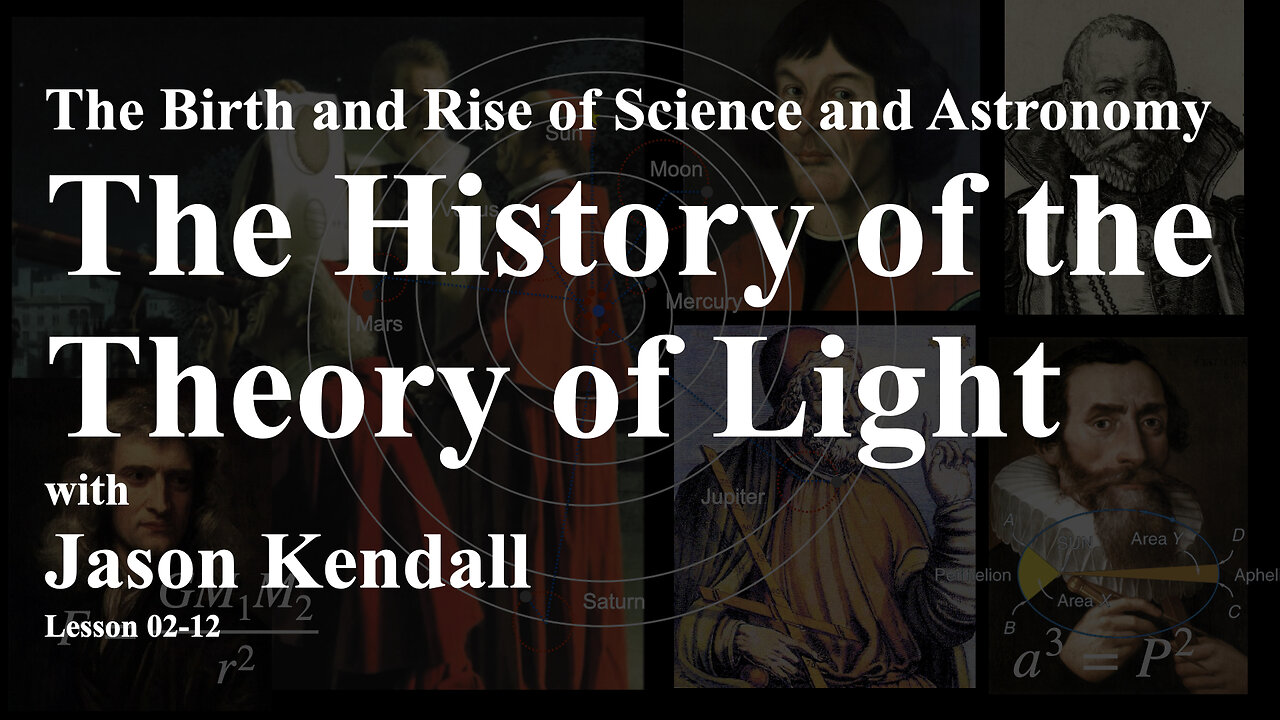Premium Only Content

From Euclid to Newton: The Evolution of Light Understanding
The study of light has been a pivotal aspect of scientific inquiry, deeply influencing our understanding of the universe. The exploration of light’s nature can be traced back to ancient philosophers, notably Euclid, who, around 300 BC, posited that light behaves according to the principles of reflection. Euclid observed that when light strikes a surface, the angle at which it reflects is equal to the angle at which it strikes, a principle that mirrors the mechanics of a ball bouncing off a wall. This foundational insight laid the groundwork for future explorations of light’s behavior.
Approximately four centuries later, the Greek astronomer Ptolemy advanced the discourse on light by investigating the phenomenon of refraction. His seminal work, the Almagest, introduced the notion that the angle of incidence of light entering a new medium, such as air into water, correlates with the angle of refraction. While Ptolemy could not quantify this relationship, he established an important conceptual framework that would inform subsequent theories.
In the 10th century, the Iraqi scholar Ibn Sahl further refined our understanding of light. He established that the ratio of the sine of the angle of incidence to the sine of the angle of refraction is equal to the ratio of the speeds of light in the two media, thereby elucidating the relationship between light’s velocity and its refraction. Although Ibn Sahl lacked the technological means to measure light’s speed, his theoretical insights were groundbreaking, emphasizing that refraction is fundamentally linked to variations in light speed across different media.
A significant leap in optical science occurred with the work of Ibn al-Haytham in the early 11th century. He fundamentally shifted the prevailing philosophical perspective by asserting that light is not emitted from the eye, but rather enters it. This revelation redefined the understanding of vision and challenged long-standing beliefs that attributed the act of seeing to the eye’s emission of light. Ibn al-Haytham’s experiments with the camera obscura, which involved allowing light to enter a darkened space through a small aperture, demonstrated how images are formed and inverted upon reaching the retina, thus paralleling the function of the human eye.
The camera obscura, as described by Ibn al-Haytham, serves as a critical analogy for understanding the eye’s operation: light reflects off objects, enters the eye, and forms an image on the retina. This understanding emerged during a time when scientific thought was flourishing in the Islamic world, particularly in Baghdad, contrasting sharply with the intellectual stagnation of Europe during the same period.
The study of light continued to evolve in the 14th century when Theodoric of Freiburg, a German philosopher, investigated the formation of rainbows. By utilizing glass vessels filled with water, he demonstrated that light could be refracted within droplets, producing a spectrum of colors. His experiments confirmed that rainbows result from the refraction of light through water, establishing a direct connection between light’s behavior and its interaction with different mediums.
This period of inquiry culminated in the 17th century with the work of Francesco Grimaldi, who provided empirical evidence of light’s wave-like behavior through diffraction. Grimaldi’s experiments revealed that light, like water waves, spreads out when passing through a narrow opening, challenging the particle theory of light that had dominated scientific thought. This discovery underscored the dual nature of light, exhibiting both particle-like and wave-like properties, a concept that would later be foundational in the field of quantum mechanics.
Isaac Newton’s contributions to the understanding of light are equally noteworthy. Through his analysis of prisms and rainbows, Newton explored the composition of white light, demonstrating that it consists of a spectrum of colors. His work solidified the wave-particle duality of light, paving the way for future advancements in optics and electromagnetism.
In summary, the exploration of light has traversed centuries and cultures, reflecting a rich tapestry of philosophical and scientific thought. From Euclid’s initial reflections on light to the intricate theories of Ibn al-Haytham and Newton, the study of light has not only enhanced our understanding of the natural world but also significantly advanced the field of physics and optics. The legacy of these early scholars continues to resonate, reminding us of the profound interconnectedness of philosophy and science in the quest for knowledge.
-
 LIVE
LIVE
BonginoReport
8 hours agoMass Migration And The Erasure Of British Culture w/ Ian Haworth - Hayley Caronia (Ep.128)
11,862 watching -
 19:51
19:51
Robbi On The Record
20 hours agoElectronic Tattoos Measuring Thoughts? From iPhone to iSkin
1085 -
 2:15:11
2:15:11
MattMorseTV
3 hours ago $6.17 earned🔴Trump's MASSIVE Oval Office ANNOUNCEMENT.🔴
16.9K23 -
 LIVE
LIVE
Nerdrotic
3 hours ago $6.20 earnedUK Has Fallen, Hollywood DOOM, DC Dysfunction | Friday Night Tights 370
2,192 watching -
 5:52:26
5:52:26
Dr Disrespect
7 hours ago🔴LIVE - DR DISRESPECT - CRONOS: The New Dawn - FIRST IMPRESSIONS
87.8K11 -
 1:30:44
1:30:44
Roseanne Barr
5 hours agoOn the Wrong Side of the Algorithm | The Roseanne Barr Podcast #114
79.9K35 -
 13:53
13:53
TundraTactical
4 hours ago $0.58 earnedFudd Finder : 11 Questions Second Amendment Questions (And Roasts) to Ask Your Friends
13.5K -
 LIVE
LIVE
Wayne Allyn Root | WAR Zone
5 hours agoWAR Zone LIVE | 5 SEPTEMBER 2025
96 watching -
 1:39:50
1:39:50
The White House
5 hours agoPresident Trump Makes Announcements, Sep. 5, 2025
27.6K18 -
 LIVE
LIVE
Red Pill News
3 hours agoBombshell Biden Docs Invalidate Autopen Pardons on Red Pill News Live
3,065 watching